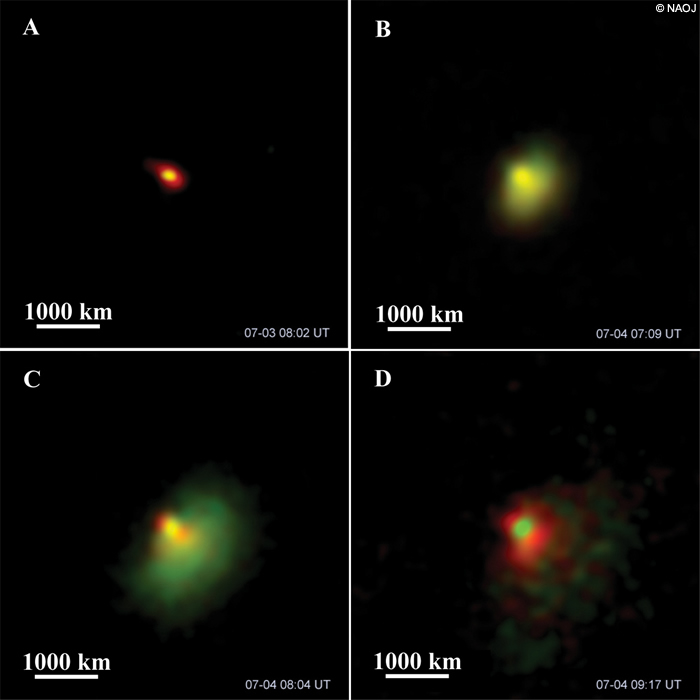The Deep Impact Mission Investigates the Origin of Comets
Astrophotography・

| Object | Comet 9P/Tempel 1 (Collision Experiment by NASA’s Deep Impact Mission) |
|---|---|
| Telescope | The Subaru Telescope |
| Instrument | COMICS (Cooled Mid Infrared Camera and Spectrometer) |
| Wavelengths | 8.8 µm, 10.5 µm, 12.4 µm composite image |
| Date | July 4, 2005 (UT) |
| Copyright | National Astronomical Observatory of Japan |
Sequential photographs in the mid-infrared show the conditions from one hour to several hours after the impactor released from the Deep Impact flyby spacecraft collided with the Jovian Comet Tempel 1. The red color shows carbon-rich material and green shows material rich in silicates (the main component of normal rocks). We can see that for several hours after the collision, the comet’s internal material expanded rapidly out into space, forming a fan shape. The results showed that the internal composition of Jovian (short-period) comets and long-period comets are extremely similar. This is very important data for theories about the origin of comets.
Long-period Comets and Jovian Comets
Long-period comets and Jovian comets differ both in terms of their momentum and in terms of the types of dust and gas which they expel. This is thought that they hail primarily from, respectively, the Oort Cloud at a distance of tens of thousands of astronomical units (au) from the Sun and the Kuiper Belt in the vicinity of 30-50 au. Whether the composition of objects is similar or different in these two very different locations is important information for understanding the origin of the Solar System.
But it was not known whether the difference between these two species of comets is a difference in the depletion levels of gas and dust, or if it is a difference in the internal composition from the time of formation.
To determine which is correct, it is necessary to peel off the gas-and-dust-depleted surface of a Jovian comet and observe the excavated pristine interior. This experiment was the goal of the Deep Impact Mission.
On the night of the experiment, we watched the experiment unfold from the summit of Mauna Kea. As the activity started to subside, it came as a big surprise as pristine silicate particles, typical of long-period comets, gushed out from the interior of the Jovian comet. The interiors of both have similar compositions.
Text by: Seiji Sugita (The University of Tokyo)
Translation by: Ramsey Lundock (NAOJ)